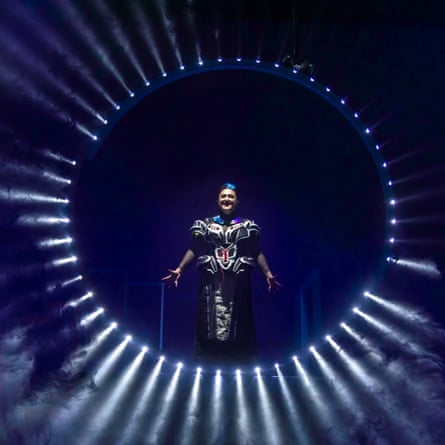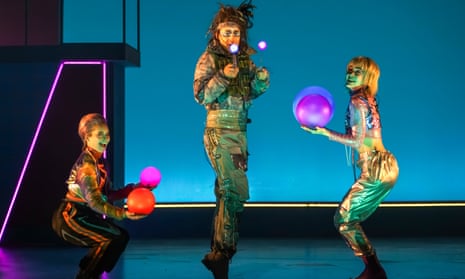Mozart and Schikaneder’s mix of pantomime and Masonry (for some, one and the same) and its triumph of good over evil counts as the most popular of all operas, but today The Magic Flute has also become one of the most problematic. In Welsh National Opera’s new staging, director Daisy Evans’s way around its acknowledged racism and misogyny is to have rewritten the libretto, creating a “modern reworking”, a generally funked-up psychedelia of colour, glowing globes and LED strip batons.
Evans’s backstory comes with the overture, making young Pamina and Tamino childhood friends, abruptly separated when Pamina is spirited away from her manic mother, Queen of the Night, by Sarastro, King of the Day. In his kingdom, Monostatos, the predatory blackamoor, becomes a camp science teacher, whose lessons Pamina finds boring. The merest nod to Masonic ritual has one of Sarastro’s sect – here called Geeks, and dressed in yellow-shorted playsuits – with a single leg rolled up.

The Magic Flute’s spoken dialogue is always tricky, all the more so here for new plot angles and too often unintelligible English, as when the Speaker, Chuma Sijeqa – all in white, headgear following Darth Vader lines – projected his speeches less well than his very impressive bass voice. The second of the two acts seemed never-ending.
Somehow the business of problem-solving managed to diminish the very magic that is Mozart, his implicit connection of music and narrative: no flute but a lightsaber, no magic bells but a pair of luminescent drumsticks brandished around. The deadly serpent is a sheet, there are no animals to be charmed, just exotically plumaged birds puppeted here, there and everywhere.

Everything is busy, blocked and choreographed to within an inch of its life. The cast threw themselves into the characterisations, but the music itself felt drained of energy and conductor Paul Daniel could not quite dispel the feeling of a disjunct between stage and pit. Raven McMillon’s Pamina brought one properly touching aria and Trystan Llŷr Griffiths’s tenor made for a robust Tamino. The three ladies were a feisty trio, with the three young things – girls not boys – their prettily sung counterpart and Quirijn de Lang’s bird-catching Papageno a strong buffer zone between all these.
Jonathan Lemalu’s Sarastro, a bewigged Enlightenment philosopher, was highly dignified and Julia Sitkovetsky a suitably crazed Queen of the Night. Her big Act Two vengeance aria provided the evening’s biggest starry spectacle but, by the end, as their realms are reconciled through Tamino and Pamina’s union, king and queen stand on high watching the jubilations and look mystified, as well they might.

Comments (…)
Sign in or create your Guardian account to join the discussion